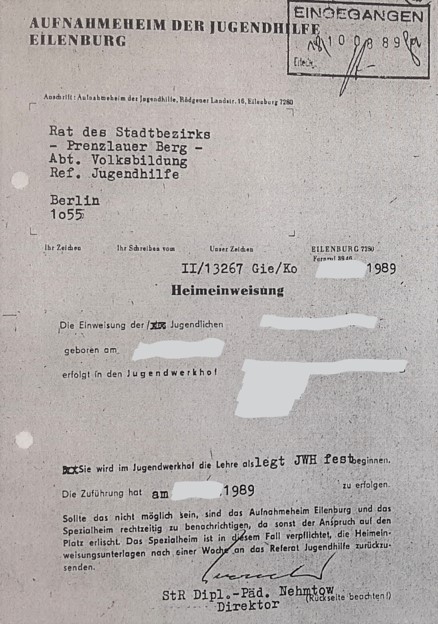Special homes
- special children's homes
- youth detention centers = Jugendwerkhöfe
- had to attend an internal school up to 8th grade, then vocational training
Since 1965, the system of special homes has consisted of special children’s homes (Spezialkinderheime), youth detention centers (Jugendwerkhöfe), special homes (Sonderheime) and the Eilenburg reception and observation home.[1] The special homes were modeled on Soviet special schools for the re-education of “difficult to educate” (schwererziehbar) minors.[2] The term “difficult to educate” distinguished this type of home from normal homes.
On the basis of this assessment, the minors concerned were placed in special homes where the compulsion to re-educate them according to the socialist conception of man was particularly strong.
“Special homes are youth welfare facilities for the re-education of minors.” – Order on Special Youth Welfare Homes of April 22, 1965
Unlike in the Federal Republic, GDR educational ideology not only sought to change the children’s personalities to conform to the rules, but also aimed to make the minors affirmatively obey the laws and principles of society. For this, breaking the will of the person concerned was considered necessary.
“The entire life in residential care serves political education.” – Eberhard Mannschatz, leading social pedagogue in the Ministry of National Education
Children and adolescents in these institutions had no place of retreat but were directly exposed to the ideological educational measures. The “educational dictatorship” of the homes resembled a “closed system within a closed system” (Dreier-Hornig, Pädagogisches Niemandsland, p. 13).
Unlike children in normal homes, inmates of special homes were not allowed to attend an external school so as to ensure complete re-education in everyday life. However, providing the internal residential schools with sufficient teaching staff confronted the authorities with major organizational difficulties, and so in 1965 it was decided to allow minors in special homes, primarily inmates of the Jugendwerkhöfe, to receive a school education only up to the eighth grade and then to integrate them into everyday working life through vocational training. As a result of their early withdrawal from school after the eighth grade, special home children were thus disadvantaged for their entire later lives, because their lower level of education, in addition to the stigmatization as a former inmate of a Jugendwerkhof, severely restricted them in their choice of occupation.
At the age of 14, young people in the GDR were obligated to work. Inmates in Jugendwerkhöfe could not choose their vocational training; training places were assigned to them by the facility administration. Most of the special home children only obtained a partial manual labor qualification (Teilfacharbeiterabschluss), which, in fact, was not recognized as a professional qualification in the Unification Treaty of 1990.
Apart from work, there was no room for individual leisure activities or personal interests for inmates of Jugendwerkhöfe. Everything was done collectively.

difficult to educate
Children and adolescents were considered to be difficult to educate if the effort to educate them to become “all-round educated people, state-conscious citizens” (Art 38 §4 GDR Constitution) was above average. Legally, the term is not defined. Reasons for designating a minor as difficult to educate include, for example, irregular attendance at school, training and work, removal from the parental home, disturbance of public order, harassment, unruliness and delinquency.
Closed Detention Center Torgau
The highest possible level in the system of sanctions intended to serve socialist re-education was the Closed detention center (Geschlossener Jugendwerkhof, GJWH) Torgau. It was established as the “final escalation stage of repressive re-education” in a former prison from the imperial era.
In the GJWH Torgau, human rights violations took place on a regular basis. For example, former inmates report punitive exercise to the point of exhaustion, extended solitary confinement in dark cells, physical violence, sexual abuse and other humiliations such as shaving off the hair of both boys and girls at the beginning of their detention.

When was a minor sent to Torgau?
Most of the admitted youth came to the GJWH Torgau from other special homes; only a few were admitted directly. The offenses that could lead to this were manifold: violations of the house rules, refusal to work, resistance to educational measures, theft, threatening other inmates and educators, damage to property, alcohol abuse, sexual offenses, escapes (“Entweichungen”) from homes, physical attacks on fellow inmates, political provocations, “behavioral disorders” and suicide attempts.
(From a list of reasons for admission from the GJWH Torgau, 1979, quoted in Dreier-Hornig, Laudien, Zwangsarbeit, p. 155.)